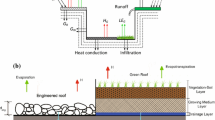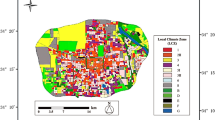Abstract
The numerical modeling of the impacts of urban buildings in mesoscale meteorological models has gradually improved in recent years. Correctly representing the latent heat flux from urban surfaces is a key issue in urban land-atmosphere coupling studies but is a common weakness in current urban canopy models. Using the surface energy balance data at a height of 140 m from a 325 m meteorological tower in Beijing, we conducted a 1-year continuous off-line simulation by using a coupled land surface model and a single-layer urban canopy model and found that this model has a relatively large systematic error for simulated latent heat flux. To improve the numerical method for modeling latent heat flux from urban surfaces, we combined observational analysis and urban land surface model to derive an oasis effect coefficient for urban green areas; to develop a temporal variation formula for water availability in urban impervious surfaces; and to specify a diurnal profile and the maximum values of anthropogenic latent heat release for four seasons. These results are directly incorporated into the urban land surface model to improve model performance. In addition, this method serves as a reference for studies in other urban areas.
Similar content being viewed by others
References
Allwine K J, Flaherty J E. 2006. Joint Urban 2003: Study overview and instrument locations. Richland, WA: Pacific Northwest National Laboratory
Barlage M, Chen F, Tewari M, et al. 2010. Noah land surface model modifications to improve snowpack prediction in the Colorado Rocky Mountains. J Geophys Res, 115: D22101
Chen, F, and Mitchell K, 1999. Using GEWEX/ISLSCP forcing data to simulate global soil moisture fields and hydrological cycle for 1987–1988. J Meteorol Soc Jpn, 77: 167–182
Chen F, Bornstein R, Grimmond S, et al. 2012. Research priorities in observing and modeling urban weather and climate. Bull Amer Meteorol Soc, 93: 1725–1728
Chen F, Dudhia J. 2001. Coupling an advanced land surface-hydrology model with the Penn State-NCAR MM5 modeling system. Part I: Model Implementation and Sensitivity. Mon Weather Rev, 129: 569–585
Chen F, Yates D N, Nagai H, et al. 2003. Land surface heterogeneity in the Cooperative Atmosphere Surface Exchange Study (CASES-97). Part I: Comparing modeled surface flux maps with surface-flux tower and aircraft measurements. J Hydrometeorol, 4: 196–218
Chen F. 2005. Variability in global land surface energy budgets during 1987–1988 simulated by an off-line land surface model. Clim Dyn, 24: 667–684
Chen F, Kusaka H, Bornstein R, et al. 2011a. The integrated WRF/urban modelling system: Development, evaluation, and applications to urban environmental problems. Int J Climatol, 31: 273–288
Chen F, Miao S, Tewari M, et al. 2011b. A numerical study of interactions between surface forcing and sea breeze circulations and their effects on stagnation in the Greater Houston area. J Geophys Res, 116: D12105
Grimmond C S B, Blackett M, Best M J, et al. 2010. The international urban energy balance models comparison project: First results from phase 1. J Appl Meteorol Climatol, 49: 1268–1292
Grimmond C S B, Blackett M, Best M J, et al. 2011. Initial results from phase 2 of the international urban energy balance model comparison. Int J Climatol, 31: 244–272
Hagishima A, Narita K, Tanimoto J. 2007. Field experiment on transpiration from isolated urban plants. Hydrol Process, 21: 1217–1222
Jiang W, Wang Y, Zhang N. 2009. Research on urban land surface process and boundary layer structure (in Chinese). Adv Earth Sci, 24: 411–419
Kawai T, Kanda M. 2010. Urban energy balance obtained from the comprehensive outdoor scale model experiment. Part i: Basic features of the surface energy balance. J Appl Meteorol Climatol, 49: 1341–1359
Kotthaus S, Grimmond C S B. 2012. Identification of micro-scale anthropogenic CO2, heat and moisture sources-processing eddy covariance fluxes for a dense urban environment. Atmos Environ, 57: 301–316
Kusaka H, Kondo H, Kikegawa Y, et al. 2001. A simple single-layer urban canopy model for atmospheric models: Comparison with multi-layer and slab models. Bound-Layer Meteorol, 101: 329–358
Lee S. 2011. Further development of the vegetated urban canopy model including a grass-covered surface parametrization and photosynthesis effects. Bound-Layer Meteorol, 140: 315–342
Lemone M A, Tewari M, Chen F, et al. 2008. Evaluation of the Noah land surface model using data from a fair-weather IHOP_2002 day with heterogeneous surface fluxes. Mon Weather Rev, 136: 4915–4941
Loridan T, Grimmond C S B, Grossman-Clarke S, et al., 2010. Trade-offs and responsiveness of the single-layer urban canopy parametrization in wrf: An offline evaluation using the MOSCEM optimization algorithm and field observations. Q J R Meteorol Soc, 136: 997–1019
Mestayer P G, Durand P, Augustin P, et al. 2005. The urban boundary-layer field campaign in Marseille (UBL/Clu-Escompte): Set-up and first results. Bound-Layer Meteorol, 114: 315–365
Miao S, Chen F, Lemone M A, et al. 2009. An observational and modeling study of characteristics of urban heat island and boundary layer structures in Beijing. J Appl Meteorol Climatol, 48: 484–501
Miao S, Chen F, Li Q, et al. 2011. Impacts of urban processes and urbanization on summer precipitation: A case study of heavy rainfall in Beijing on 1 August 2006. J Appl Meteorol Climatol, 50: 806–825
Miao S, Chen F. 2008. Formation of horizontal convective rolls in urban areas. Atmos Res, 89: 298–304
Miao S, Dou J X, Chen F, et al. 2012. Analysis of observations on the urban surface energy balance in Beijing. Sci China Earth Sci, 42: 1394–1402
Moriwaki R, Kanda M, Senoo H, et al. 2008. Anthropogenic water vapor emissions in Tokyo. Water Resour Res, 44: W11424
Rotach M W, Vogt R, Bernhofer C, et al. 2005. BUBBLE-An urban boundary layer meteorology project. Theor Appl Climatol, 81: 231–261
Ryu Y, Baik J, Lee S. 2011. A new single-layer urban canopy model for use in mesoscale atmospheric models. J Appl Meteorol Climatol, 50: 1773–1794
Schlünzen K H, Katzfey J J. 2003. Relevance of sub-grid-scale land-use effects for mesoscale models. Tellus Ser A-Dyn Meteorol Oceanol, 55: 232–246
Sridhar V, Elliott R L, Chen F, et al. 2002. Validation of the NOAH-OSU land surface model using surface flux measurements in Oklahoma. J Geophys Res, 2002, 107: 4418
Thatcher M, Hurley P. 2012. Simulating Australian urban climate in a mesoscale atmospheric numerical model. Bound-Layer Meteorol, 142: 149–175
Wang G T, Wang X Y, Miao S G, et al. 2005. Research and application on the technology system of multi-scale assessment of the impact on the atmospheric environment by urban planning. Sci China Ser D-Earth Sci, 48(Suppl 2): 173–184
Wang Y, Jiang W, Liu H. 2008. Advanced in research of urban effect parameterization scheme on models of atmosphere. Adv Earth Sci, 23: 371–381
Wang Y, Liang X, Miao S, et al. 2012. Perspective and prospect of urban meteorology research (in Chinese). Meteorol Mon, 38: 1232–1237
Welty C. 2009. The urban water budget. In: Baker L A, ed. The Water Environment of Cities. New York: Springer. 17–28
Willmott C J. 1982. Some comments on the evaluation of model performance. Bull Amer Meteorol Soc, 63: 1309–1313
Author information
Authors and Affiliations
Corresponding author
Rights and permissions
About this article
Cite this article
Miao, S., Chen, F. Enhanced modeling of latent heat flux from urban surfaces in the Noah/single-layer urban canopy coupled model. Sci. China Earth Sci. 57, 2408–2416 (2014). https://doi.org/10.1007/s11430-014-4829-0
Received:
Accepted:
Published:
Issue Date:
DOI: https://doi.org/10.1007/s11430-014-4829-0




